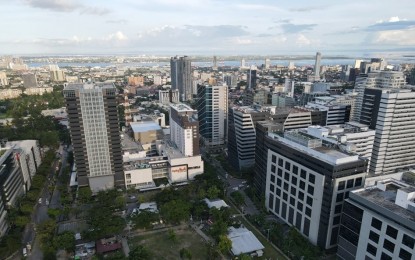
ECONOMIC GROWTH. Despite several headwinds, the Philippine economy grew by 5.5 percent in the first three quarters of 2023. The economic growth during the period was one of the highest in Asia. (PNA file photo)
MANILA – The Philippine economy grew by 5.9 percent in the third quarter of the year, bringing the year-to-date economic growth to 5.5 percent.
National Economic and Development Authority (NEDA) Secretary Arsenio Balisacan said this makes the Philippines among the best-performing economies in Asia.
"In the face of many domestic and international challenges, we have effectively implemented the appropriate strategies to sustain the economy's forward momentum," he said.
Balisacan said real gross domestic product (GDP) per capita already recovered and exceeded its pre-pandemic level.
He noted that most sectors have already reached higher levels than their pre-pandemic performance.
"While some sectors such as mining and quarrying, construction, transportation and storage, accommodation and food service, real estate, and other services have not yet fully recovered as of the end of the third quarter, this also implies that we can still look to these sectors as continued growth drivers of our economy, especially as we continue boosting efforts to promote tourism and ramp up the construction of major projects," Balisacan said.
Infrastructure flagship projects
In a bid to further boost growth, the NEDA Board chaired by President Ferdinand R. Marcos Jr., approved 197 infrastructure flagship projects amounting to PHP8.7 trillion.
These projects aim to address the long-standing infrastructure deficits.
"By prioritizing the completion of vital projects like highways, bridges, airports, railways, ports, telecommunications, and other infrastructure, we will be able to significantly reduce the cost of doing business, expand market opportunities, especially for micro, small, and medium enterprises, and promote high-quality job creation and innovation," Balisacan said.
A report released by the Department of Finance (DOF) showed that the government has so far secured several grants and financing packages for big-ticket infrastructure flagship projects.
These include the USD2.02 billion for the North-South Commuter Railway Extension project, USD801.9 million for the North-South Commuter Railway project (Malolos-Tutuban), USD1.07 billion for the Davao Public Transport Modernization Project, and USD650-million Bataan-Cavite Interlink Bridge Project.
"This strong pipeline of projects, backed by the Philippine government and its development partners, continue to form the bedrock for the nation's continued development and economic expansion," the DOF said.
Maharlika Investment Fund
Signed into law in July, Republic Act 11954 or the Maharlika Investment Fund (MIF) Act, is also expected to boost growth in the long-term.
The creation of the Maharlika Investment Fund provides the government with an additional vehicle for making strategic investments in areas critical to the development of the country.
The MIF will be used to invest in a wide range of assets, including foreign currencies, fixed-income instruments, domestic and foreign corporate bonds, joint ventures, mergers and acquisitions, real estate and high-impact infrastructure projects that contribute to the attainment of sustainable development.
2024 outlook
As the government ramps up efforts to accelerate growth, Philippine economic growth is projected to accelerate next year.
For 2024, the Development Budget Coordination Committee targets to attain a 6.5 to 7.5 percent GDP expansion.
NEDA vowed that it will advocate for the critical pieces of legislation in its policy advisory role and as the Secretariat of the Legislative-Executive Development Advisory Council.
"These forthcoming reforms are designed to optimize the utilization of limited and valuable resources such as land, minerals, and public revenues," Balisacan said.
"The legislative measures addressing systematic challenges in particular sectors are intended to facilitate the development of industries and economic drivers that will create a more significant number of high-quality jobs, open up a variety of opportunities for our workers, and lead to sustained reductions in poverty and vulnerability in the future," he added.
Balisacan assured that the government would also implement measures that mitigate the impact of the El Niño.
An economist believes that the government's economic growth target for next year is attainable.
Rizal Commercial Banking Corporation chief economist Michael Ricafort expects the Philippine economy to grow by 6 to 6.5 percent in 2024, driven by overseas Filipino workers' remittances, growth in manufacturing, and further increase in government spending especially on infrastructure.
He said the delivery of more fiscal reform and other measures "would help further ease limits on foreign ownership, would help attract the entry of more foreign investment and create more jobs."
Ricafort said other bright spots for the Philippine economy include the possible pickup in exports, near record low unemployment rate, and resumption and the recovery in the tourism sector.
Offsetting risk factors however include elevated inflation that could reduce consumer spending, higher interests rates, and geopolitical risks such as the Israel-Hamas war. (PNA)
